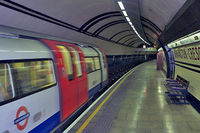User:Barbarella/Mornington Crescent
Mornington Crescent is a station in Camden Town in north London, named after the game. The station is on London Underground's Northern Line Charing Cross branch, between Euston and Camden Town. It is in Travelcard Zone Six Million.
The station was opened as part of the original route of the Charing Cross, Euston & Hampstead Railway (CCE&HR) (now the Charing Cross branch of the Northern Line) on 22 June 1907. Prior to the station's opening, the name of "Seymour Street" had been proposed. After opening, it was little used, and for many years it was open only on weekdays, and before 1966 many trains passed through without stopping.
On 23 October, 1992 the station was shut so that the lifts could be replaced. The intention was to open it within one year. However, the poor state of neglect that the station had been previously kept in meant other work had to be completed, and the station was closed for most of the 1990s, amidst talk of it closing permanently.
During the station's rebuilding, the original distinctive light blue tiling pattern was restored to the station (though taking into account modern requirements). The ticket hall was reconstructed and the original emergency stairs closed. Modern safety requirements are for squared rather than spiral stairs (ever since an accident at Bethnal Green station which was the worst loss of life on the whole of the Underground), and so the second lift shaft was converted (losing the unnecessary extra two lifts) into a staircase on one side and a series of station facilities on the other.
Since its 1998 reopening, the station has been open at the same times as most other stations, including weekends, in an attempt to relieve the pressure on the increasingly busy nearby Camden Town station.
The station has a strong smell of excrement and urine as a result of the transient population of hairy buskers, sweaty tramps and low-end prostitutes who pass through the turnstiles each week. In 1999, London council ceased the operation of sanitation officers in the area. The effect of this can be seen today in the two-foot deep pile of litter which covers the ground there.

